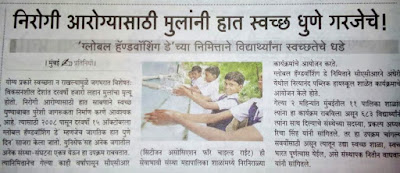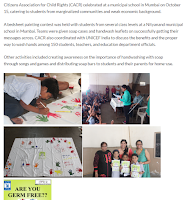As everyone celebrated Children's Day in India on November 14th, it took me back in time when I was in middle school. I distinctly recollect that mathematics wasn't exactly my strong suit. Pursuing the search for ‘X’ didn't appeal to me while I greatly enjoyed my time in the science lab and playing throwball on the school ground.
But surprisingly, all this changed in high school when Geometry and Algebra became my favourite subjects to the point that I scored full marks in two consecutive exams and loved solving tougher problems and puzzles even after school. The biggest factor contributing to this change was the new teacher- Motwyn Sir, the teacher who started teaching us math. The theorems and corollaries that earlier appeared dry and difficult were now fun to learn. Even today you will find a strong correlation between a student’s favourite teacher and subject; the contrary is true as well.
 |
| Fear of Mathematics |
But surprisingly, all this changed in high school when Geometry and Algebra became my favourite subjects to the point that I scored full marks in two consecutive exams and loved solving tougher problems and puzzles even after school. The biggest factor contributing to this change was the new teacher- Motwyn Sir, the teacher who started teaching us math. The theorems and corollaries that earlier appeared dry and difficult were now fun to learn. Even today you will find a strong correlation between a student’s favourite teacher and subject; the contrary is true as well.
What did the teacher do to change things? Surprising, he didn't teach us much, I recollect. Yes, you read it right.
He did NOT believe in teaching students but rather helping them to understand, to communicate their findings, and to learn from each other. The impetus in the classroom was not to give us notes and solve the sum but to talk to us about the ways we thought the problem could be tackled and encourage all students to participate in the discussion. We never moved forward until every doubt was solved.
He did NOT believe in teaching students but rather helping them to understand, to communicate their findings, and to learn from each other. The impetus in the classroom was not to give us notes and solve the sum but to talk to us about the ways we thought the problem could be tackled and encourage all students to participate in the discussion. We never moved forward until every doubt was solved.
Unfortunately, in most schools, the focus is still on teaching, memorising, and rote-learning. Very few institutions appreciate the benefits of allowing the student to develop an original thinking, reasoning, and analysis. This problem is not only found in our Indian schools but also in higher academic institutes.
The question we need to ask is – Do we want to create crammers or innovators?
But if cramming gets you 90% marks on that school report card, parents and the school really don’t bother to reflect on this. This gains importance only in later life when young college students or graduates are compelled to debate, give their opinion, and solve real-life problems and those who can’t think critically suffer.
Today, I am on the other side of the classroom. Teaching students myself as a CACR volunteer and project head for computer literacy project that aims to bridge the technology divide in India. When I interact with students from municipal (inner city) schools in Mumbai, I keep the same principle in mind – not to merely teach students but listen to them and encourage them to ask questions and think.
Having taught students under this project for the past 2 years, I can say for sure that the students are more capable of learning new things on their own and from each other than we can imagine. For instance- Despite coming from low-income households that don’t have access to computers, these students picked up the content pretty quickly for children who were exposed to technology the first time. When we returned to take sessions after vacations, the quick learners had already taught a thing or two to their classmates and brought them up to speed.
Now with the advent of self-learning software, virtual education, and free e-learning materials widely available on the web, the teacher’s role in classrooms has changed from teaching the students to motivating them to learn new skills and encourage experimentation.
A teacher plays a pivotal role in a student’s life to lay a robust foundation for future tasks and challenges she/he will face. It is about time all the stakeholders -the education system, parents, students and teachers recognise this and pave the way to give society thought leaders, entrepreneurs, innovators, risk-takers, artists, sportsmen and the like. Together let us create a system of innovative learning, not just teaching.
The article first appeared Here on LinkedIn Pulse and has been reproduced by author's permission.
+Richa Singh is member of CACR a Non-profit working in areas of education and healthcare in government schools of Mumbai
Image: http://www.mcny.edu/student_serv/lecblog/math-phobia+Richa Singh is member of CACR a Non-profit working in areas of education and healthcare in government schools of Mumbai





